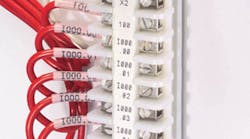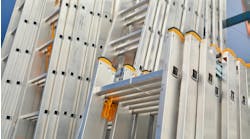Good labeling practices reduce installation costs and increase customer satisfaction.
A new paper mill in South Carolina delayed construction for several days—and lost several million dollars—because of labeling errors in major cable pulls for the lime kiln controls. The contractor not only paid a late completion penalty, but also lost face and future work with that customer. You’ve probably encountered frustrations during cable terminations or acceptance testing because of problems with equipment identification or wire labeling, too, but you can prevent them if you understand the timesaving tools and techniques available to you.
Today, we jam new buildings full of computers, networks, and other high-tech equipment. Since last September, facilities are upgrading requirements for fire detection and protection, access and security, surveillance, and emergency communications systems. Cable management—keeping track of cables and wires during and after installation—is hard in the new construction market; the retrofit market poses special challenges that make the job even tougher. First-rate identification is your first line of defense in the battle to properly manage cables.
Standards and practices. Because the NEC only gives the minimum standards for safety, you must go beyond Code compliance to effectively manage cable. For example, the NEC requires the identification of cabling and wiring in electrical constructions, but it doesn’t specify methods or materials. This means you must rely on other specifications, such as military standards to finish the job, or you can use collective experience to establish standards that make sense for the kind of work you do. Consider the following rules of thumb when setting standards:
-
Obtain site naming and numbering conventions from your customer early in the design stage. If those conventions are loose or absent, then develop conventions for the customer to approve.
-
Create a naming and numbering system that follows a logical hierarchy. For example, 1-FDWR-MKUP-PUMP-02-PRSR-0008 would designate Unit 1 Feed Water Makeup Pump Number Two, Pressure Loop, Item 8. Notice the abbreviations fit into four character spaces and the item number has four digit places. This allows for standardization of label sizes and makes for much easier reading when looking inside a panel. Create a master index of these items to guide project drawings.
-
Don’t overlabel. Good panel layout, wireway ID, and cable ID will usually allow you to put minimal information on individual wires. Cluttering your wiring with unwieldy labels makes no sense.
-
Ensure your naming and numbering system and your system drawings reflect the same information. Don’t mix and match abbreviations, control loop numbers, or other identification standards between them.
-
Don’t use hand-written labels. Use printed identification because it’s neat, easy to read, and time-efficient. Use the simplest font type.
Job site efficiency. As the number of wire pulls and terminations increases, so does the potential cost of labeling, which often leads to poor labeling. A good job of labeling pays for itself—whether in construction or maintenance costs. Refer to the following tips to increase labeling efficiency.
-
Use the right printer for the job. Identification product companies will help you choose the print technology and tools to do the job right.
-
Temporarily label wires before pulling. You don’t need to label every conductor. If you make 10 pulls into a cabinet and label two conductors in each pull with that pull number, you reduce the time it takes for maintenance workers to find the right bundle. If you have room, label each conductor, but stagger the labels so they don’t line up to form a bulge during the pull. As you cut the wires for layout and termination, apply permanent labels. Using one set of labels for both functions—pulling and terminating—is usually not economical.
-
For panels and areas with large concentrations of terminations, print labels ahead of time. That way an electrician can just tear labels off a sheet while following the wiring chart. Good label machines are easy to use, allowing you to shift the labor cost of creating these labels to a much lower burden rate instead of forcing electricians to print their own in the field.
-
When terminating in a panel, apply the labels as you go. This gives a neat appearance and allows you to ensure the labels line up properly.
-
In case of errors, provide the field crew with the means to make labels. It’s much cheaper for a person to make a few labels on the spot than to involve a chain of communication and delivery in doing so.
You can’t get away from identifying equipment, wiring, or wiring terminals—it’s part of every job. How well you do that will affect the profitability of every job and the customer perception of your workmanship. Labeling is the key to an effective identification program. Making the labeling job as easy as possible on your crews is a worthwhile goal. Proper planning of your labeling—setting standards and providing the right equipment to meet them—saves time in everything from wire pulls to acceptance testing.
Nancy Kane is the electrical/datacom industry manager for Brady Corp., Inc., Milwaukee, and Corona is a technical writer, also with Brady Corp., Inc.



